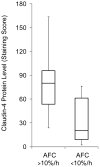Claudins and alveolar epithelial barrier function in the lung
- PMID: 22671604
- PMCID: PMC4864024
- DOI: 10.1111/j.1749-6632.2012.06533.x
Claudins and alveolar epithelial barrier function in the lung
Abstract
The alveolar epithelium of the lung constitutes a unique interface with the outside environment. This thin barrier must maintain a surface for gas transfer while being continuously exposed to potentially hazardous environmental stimuli. Small differences in alveolar epithelial barrier properties could therefore have a large impact on disease susceptibility or outcome. Moreover, recent work has focused attention on the alveolar epithelium as central to several lung diseases, including acute lung injury and idiopathic pulmonary fibrosis. Although relatively little is known about the function and regulation of claudin tight junction proteins in the lung, new evidence suggests that environmental stimuli can influence claudin expression and alveolar barrier function in human disease. This review considers recent advances in the understanding of the role of claudins in the breakdown of the alveolar epithelial barrier in disease and in epithelial repair.
© 2012 New York Academy of Sciences.
Figures




References
-
- Tsukita S, Yamazaki Y, Katsuno T, Tamura A. Tight junction-based epithelial microenvironment and cell proliferation. Oncogene. 2008;27:6930–6938. - PubMed
-
- Gorin AB, Stewart PA. Differential permeability of endothelial and epithelial barriers to albumin flux. J Appl Physiol. 1979;47:1315–1324. - PubMed
-
- Vreim CR, Snashall PD, Demling RH, Staub NC. Lung lymph and free interstitial fluid protein composition in sheep with edema. Am J Physiol. 1976;230:1650–1653. - PubMed
-
- Matthay MA, Folkesson HG, Clerici C. Lung epithelial fluid transport and the resolution of pulmonary edema. Physiol Rev. 2002;82:569–600. - PubMed
-
- Matthay MA, Robriquet L, Fang X. Alveolar epithelium: role in lung fluid balance and acute lung injury. Proc Am Thorac Soc. 2005;2:206–213. - PubMed

